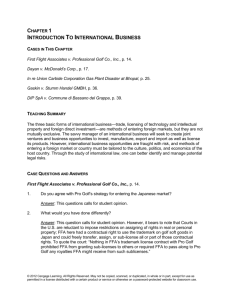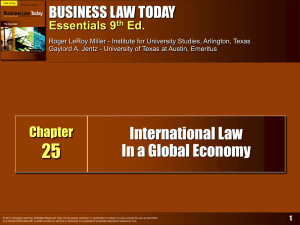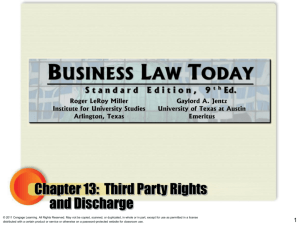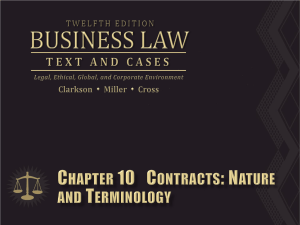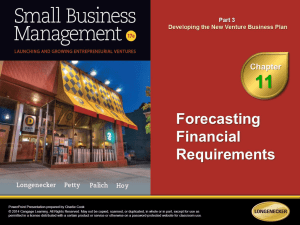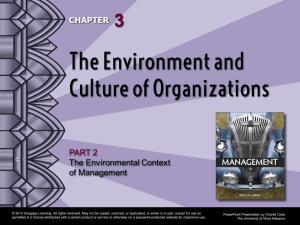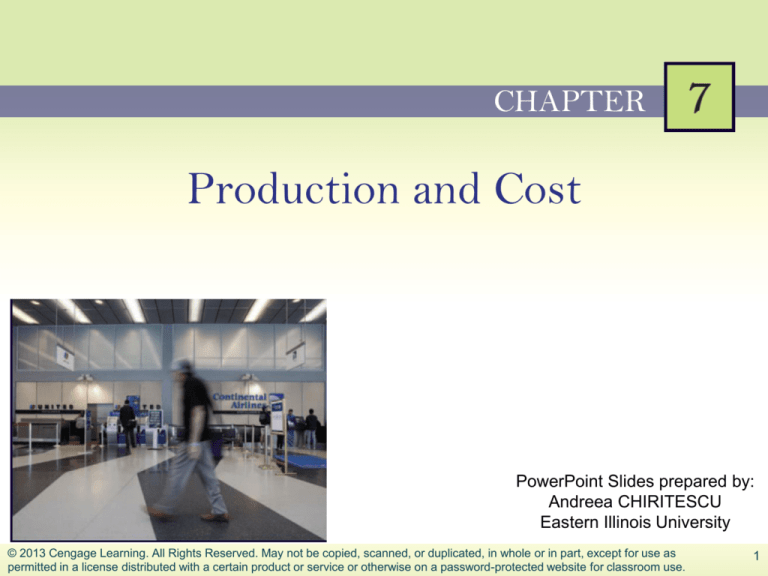
CHAPTER
Production and Cost
PowerPoint Slides
Slides prepared
prepared by:
by:
PowerPoint
Andreea CHIRITESCU
CHIRITESCU
Andreea
Eastern Illinois
Illinois University
University
Eastern
© 2013 Cengage Learning. All Rights Reserved. May not be copied, scanned, or duplicated, in whole or in part, except for use as
permitted in a license distributed with a certain product or service or otherwise on a password-protected website for classroom use.
1
Production
• Profit
– Total revenue minus total cost
• Business firm
– Organization, owned and operated by
private individuals
– Specializes in production
• Production
– Process of combining inputs to make
goods and services
© 2013 Cengage Learning. All Rights Reserved. May not be copied, scanned, or duplicated, in whole or in part, except for use as
permitted in a license distributed with a certain product or service or otherwise on a password-protected website for classroom use.
2
Production
• Technology
– Methods available for combining inputs to
produce a good or service
• Assumption
– Production technology
– Firm uses only two inputs: capital and
labor
• Long run
– A time horizon long enough for a firm to
vary all of its inputs
© 2013 Cengage Learning. All Rights Reserved. May not be copied, scanned, or duplicated, in whole or in part, except for use as
permitted in a license distributed with a certain product or service or otherwise on a password-protected website for classroom use.
3
Production
• Variable input
– An input whose usage can change over
some time period
• Fixed input
– An input whose quantity must remain
constant over some time period
• Short run
– A time horizon during which at least one of
the firm’s inputs cannot be varied
© 2013 Cengage Learning. All Rights Reserved. May not be copied, scanned, or duplicated, in whole or in part, except for use as
permitted in a license distributed with a certain product or service or otherwise on a password-protected website for classroom use.
4
Production in the Short Run
• Total product
– The maximum quantity of output that can
be produced from a given combination of
inputs
– E.g.: maximum output for each number of
workers
• Total product curve
– Horizontal axis: number of workers
– Vertical axis: total product
© 2013 Cengage Learning. All Rights Reserved. May not be copied, scanned, or duplicated, in whole or in part, except for use as
permitted in a license distributed with a certain product or service or otherwise on a password-protected website for classroom use.
5
Table
1
Short-Run Production at Spotless Car Wash
© 2013 Cengage Learning. All Rights Reserved. May not be copied, scanned, or duplicated, in whole or in part, except for use as
permitted in a license distributed with a certain product or service or otherwise on a password-protected website for classroom use.
6
Production in the Short Run
• Marginal product of labor (MPL= ΔQ/ΔL)
– The additional output produced when one
more worker is hired
– Change in total product (ΔQ) divided by
the change in the number of workers
employed (ΔL)
– Tells us the rise in output produced when
one more worker is hired
© 2013 Cengage Learning. All Rights Reserved. May not be copied, scanned, or duplicated, in whole or in part, except for use as
permitted in a license distributed with a certain product or service or otherwise on a password-protected website for classroom use.
7
Production in the Short Run
• Increasing marginal returns to labor
– The marginal product of labor increases as
more labor is hired
• Diminishing marginal returns to labor
– The marginal product of labor decreases
as more labor is hired
• Law of diminishing (marginal) returns
– As we continue to add more of any one
input, holding the other inputs constant
– Its marginal product will eventually decline
© 2013 Cengage Learning. All Rights Reserved. May not be copied, scanned, or duplicated, in whole or in part, except for use as
permitted in a license distributed with a certain product or service or otherwise on a password-protected website for classroom use.
8
Figure 1
Total and Marginal Product
Units of
output 196
184
Total product
160
ΔQ from hiring fourth worker = 30
130
ΔQ from hiring third worker = 40
90
ΔQ from hiring second worker = 60
30
ΔQ from hiring first worker = 30
1
Increasing
marginal
returns
2
3
4
5
6
Number of workers
Diminishing
marginal
returns
© 2013 Cengage Learning. All Rights Reserved. May not be copied, scanned, or duplicated, in whole or in part, except for use as
permitted in a license distributed with a certain product or service or otherwise on a password-protected website for classroom use.
9
Thinking About Costs
• A firm’s total cost
– Of producing a given level of output
– Is the opportunity cost of the owners
• Everything they must give up in order to
produce that amount of output
• Implicit and explicit costs
© 2013 Cengage Learning. All Rights Reserved. May not be copied, scanned, or duplicated, in whole or in part, except for use as
permitted in a license distributed with a certain product or service or otherwise on a password-protected website for classroom use.
10
Thinking About Costs
• Sunk cost
– Cost that has been paid or must be paid
– Regardless of any future action being
considered
– Should not be considered when making
decisions
© 2013 Cengage Learning. All Rights Reserved. May not be copied, scanned, or duplicated, in whole or in part, except for use as
permitted in a license distributed with a certain product or service or otherwise on a password-protected website for classroom use.
11
Thinking About Costs
• Explicit costs
– Involve actual payments
• Implicit costs
– No money changes hands
• Forgone rent
• Forgone interest
• Forgone labor income
© 2013 Cengage Learning. All Rights Reserved. May not be copied, scanned, or duplicated, in whole or in part, except for use as
permitted in a license distributed with a certain product or service or otherwise on a password-protected website for classroom use.
12
Table
2
A Firm’s Costs
© 2013 Cengage Learning. All Rights Reserved. May not be copied, scanned, or duplicated, in whole or in part, except for use as
permitted in a license distributed with a certain product or service or otherwise on a password-protected website for classroom use.
13
Thinking About Costs
• Least-Cost Rule
– A firm produces any given output level
using the lowest cost combination of inputs
available
• Least-cost input combination depends on
– Nature of the firm’s technology
– Prices the firm must pay for its inputs
– Time horizon for the firm’s planning
© 2013 Cengage Learning. All Rights Reserved. May not be copied, scanned, or duplicated, in whole or in part, except for use as
permitted in a license distributed with a certain product or service or otherwise on a password-protected website for classroom use.
14
Cost in the Short Run
• Fixed costs
– Costs of fixed inputs
– Remain constant as output changes
• Variable costs
– Costs of variable inputs
– Change with output
© 2013 Cengage Learning. All Rights Reserved. May not be copied, scanned, or duplicated, in whole or in part, except for use as
permitted in a license distributed with a certain product or service or otherwise on a password-protected website for classroom use.
15
Table
3
Short-Run Costs for Spotless Car Wash
© 2013 Cengage Learning. All Rights Reserved. May not be copied, scanned, or duplicated, in whole or in part, except for use as
permitted in a license distributed with a certain product or service or otherwise on a password-protected website for classroom use.
16
Cost in the Short Run
• Total fixed cost (TFC)
– The cost of all inputs that are fixed in the
short run
• Total variable cost (TVC)
– The cost of all variable inputs used in
producing a particular level of output
• Total cost (TC = TFC + TVC)
– The costs of all inputs, fixed and variable,
used to produce a given output level in the
short run
© 2013 Cengage Learning. All Rights Reserved. May not be copied, scanned, or duplicated, in whole or in part, except for use as
permitted in a license distributed with a certain product or service or otherwise on a password-protected website for classroom use.
17
Figure 2
The Firm’s Total Cost Curves
Dollars
TC
$870
TFC = $150
TVC
750
630
510
390
270
TFC
30
90
130
160
184
Units of Output
At any level of output, total cost (TC) is the sum of total fixed cost (TFC) and total variable cost
(TVC)
© 2013 Cengage Learning. All Rights Reserved. May not be copied, scanned, or duplicated, in whole or in part, except for use as
permitted in a license distributed with a certain product or service or otherwise on a password-protected website for classroom use.
18
Cost in the Short Run
• Average fixed cost (AFC = TFC / Q)
– Total fixed cost divided by the quantity of
output produced
• Average variable cost (AVC = TVC / Q)
– Total variable cost divided by the quantity
of output produced
• Average total cost (ATC = TC / Q)
– Total cost divided by the quantity of output
produced
© 2013 Cengage Learning. All Rights Reserved. May not be copied, scanned, or duplicated, in whole or in part, except for use as
permitted in a license distributed with a certain product or service or otherwise on a password-protected website for classroom use.
19
Cost in the Short Run
• Marginal cost (MC = ΔTC / ΔQ)
– The increase in total cost from producing
one more unit of output
– It tells us how much cost rises per unit
increase in output
© 2013 Cengage Learning. All Rights Reserved. May not be copied, scanned, or duplicated, in whole or in part, except for use as
permitted in a license distributed with a certain product or service or otherwise on a password-protected website for classroom use.
20
Figure 3
Average and Marginal Costs
Average variable cost
(AVC) and average total
MC
cost (ATC) are Ushaped, first decreasing
and then increasing.
Average fixed cost
(AFC), the vertical
distance between ATC
and AVC, becomes
smaller as output
ATC increases. The marginal
cost (MC) curve is also
AVC U-shaped, reflecting
first increasing and then
diminishing marginal
returns to labor. MC
passes through the
minimum points of both
the AVC and ATC
curves.
Dollars
$10
8
6
AFC
4
2
30
90
130
160
184 196
Units of
Output
© 2013 Cengage Learning. All Rights Reserved. May not be copied, scanned, or duplicated, in whole or in part, except for use as
permitted in a license distributed with a certain product or service or otherwise on a password-protected website for classroom use.
21
Cost in the Short Run
• Explaining the shape of the MC curve
– When the marginal product of labor (MPL)
rises, marginal cost (MC) falls
– When MPL falls, MC rises
– Since MPL ordinarily rises and then falls,
MC will do the opposite
– MC curve is U-shaped
• Increasing then diminishing marginal returns
to labor
© 2013 Cengage Learning. All Rights Reserved. May not be copied, scanned, or duplicated, in whole or in part, except for use as
permitted in a license distributed with a certain product or service or otherwise on a password-protected website for classroom use.
22
Table
4
Average and Marginal Test Scores
© 2013 Cengage Learning. All Rights Reserved. May not be copied, scanned, or duplicated, in whole or in part, except for use as
permitted in a license distributed with a certain product or service or otherwise on a password-protected website for classroom use.
23
Cost in the Short Run
• ATC curve is U-shaped
– Because AFC decreases and AVC first
decreases, then increases
– At low levels of output, AVC and AFC are
both falling, so the ATC curve slopes
downward
– At higher levels of output, rising AVC
overcomes falling AFC, and the ATC curve
slopes upward
© 2013 Cengage Learning. All Rights Reserved. May not be copied, scanned, or duplicated, in whole or in part, except for use as
permitted in a license distributed with a certain product or service or otherwise on a password-protected website for classroom use.
24
Cost in the Short Run
• AVC curve is U-shaped
– Because MC curve is U-shaped
(increasing and then diminishing returns to
labor)
• MC curve
– Crosses both the AVC curve and the ATC
curve at their respective minimum points
© 2013 Cengage Learning. All Rights Reserved. May not be copied, scanned, or duplicated, in whole or in part, except for use as
permitted in a license distributed with a certain product or service or otherwise on a password-protected website for classroom use.
25
Production and Cost in the Long Run
• In the long run
– No fixed inputs; no fixed costs
– All inputs and all costs are variable
• Output production
– Least-cost rule
• Long-run total cost (LRTC)
– Cost of producing each quantity of output
when all inputs are variable and the leastcost input mix is chosen
© 2013 Cengage Learning. All Rights Reserved. May not be copied, scanned, or duplicated, in whole or in part, except for use as
permitted in a license distributed with a certain product or service or otherwise on a password-protected website for classroom use.
26
Production and Cost in the Long Run
• Long-run average total cost (LRATC =
LRTC / Q)
– Cost per unit of producing each quantity of
output, in the long run, when all inputs are
variable
– Long-run total cost divided by quantity
• Relationship between long-run and shortrun costs
– LRTC ≤ TC
– LRATC ≤ ATC
© 2013 Cengage Learning. All Rights Reserved. May not be copied, scanned, or duplicated, in whole or in part, except for use as
permitted in a license distributed with a certain product or service or otherwise on a password-protected website for classroom use.
27
Table
5
Four Ways to Wash 196 Cars per Day
© 2013 Cengage Learning. All Rights Reserved. May not be copied, scanned, or duplicated, in whole or in part, except for use as
permitted in a license distributed with a certain product or service or otherwise on a password-protected website for classroom use.
28
Table
6
Long-Run Costs for Spotless Car Wash
© 2013 Cengage Learning. All Rights Reserved. May not be copied, scanned, or duplicated, in whole or in part, except for use as
permitted in a license distributed with a certain product or service or otherwise on a password-protected website for classroom use.
29
Production and Cost in the Long Run
• Plant
– The collection of fixed inputs at a firm’s
disposal
• Size of the firm’s plant
– Can be changed in the long run
– Cannot be changed in the short run
© 2013 Cengage Learning. All Rights Reserved. May not be copied, scanned, or duplicated, in whole or in part, except for use as
permitted in a license distributed with a certain product or service or otherwise on a password-protected website for classroom use.
30
Production and Cost in the Long Run
• A firm’s LRATC curve
– Combines portions of each ATC curve
available to the firm in the long run
– For each output level, the firm will always
choose to operate on the ATC curve with
the lowest possible cost
© 2013 Cengage Learning. All Rights Reserved. May not be copied, scanned, or duplicated, in whole or in part, except for use as
permitted in a license distributed with a certain product or service or otherwise on a password-protected website for classroom use.
31
Production and Cost in the Long Run
• In the short run
– A firm can only move along its current ATC
curve
• In the long run
– A firm can move from one ATC curve to
another
• By varying the size of its plant
• Moving along its LRATC curve
© 2013 Cengage Learning. All Rights Reserved. May not be copied, scanned, or duplicated, in whole or in part, except for use as
permitted in a license distributed with a certain product or service or otherwise on a password-protected website for classroom use.
32
Figure 4
Long-Run Average Total Cost
Dollars
$8.00
ATC0
ATC2
ATC1
ATC3
C
$6.00
B
D
LRATC
$4.00
A
E
$2.00
0
30
Use 0
automated
lines
90
130
Use 1
automated
lines
175
184
250
Use 2
automated
lines
Average-total cost
curves ATC0, ATC1,
ATC2, and ATC3 show
average costs when the
firm has zero, one, two,
and three automated
lines, respectively. The
LRATC curve combines
portions of all the firm’s
ATC curves. In the long
run, the firm will choose
the lowest-cost ATC
curve for each level of
output.
300 Units of Output
Use 3
automated
lines
© 2013 Cengage Learning. All Rights Reserved. May not be copied, scanned, or duplicated, in whole or in part, except for use as
permitted in a license distributed with a certain product or service or otherwise on a password-protected website for classroom use.
33
Production and Cost in the Long Run
• The U-shape of the LRATC curve:
– As output increases, long-run average
costs:
– First decline (economies of scale)
– Then remain constant (constant returns to
scale)
– And finally rise (diseconomies of scale)
© 2013 Cengage Learning. All Rights Reserved. May not be copied, scanned, or duplicated, in whole or in part, except for use as
permitted in a license distributed with a certain product or service or otherwise on a password-protected website for classroom use.
34
Production and Cost in the Long Run
• Economies of scale
– Long-run average total cost decreases as
output increases
– LRATC curve slopes downward
– Long-run total cost rises proportionately
less than output
• Causes for economies of scale
– Gains from specialization
– Spreading costs of lumpy inputs
© 2013 Cengage Learning. All Rights Reserved. May not be copied, scanned, or duplicated, in whole or in part, except for use as
permitted in a license distributed with a certain product or service or otherwise on a password-protected website for classroom use.
35
Production and Cost in the Long Run
• Lumpy input
– An input whose quantity cannot be
increased gradually as output increases
– But must instead be adjusted in large
jumps
© 2013 Cengage Learning. All Rights Reserved. May not be copied, scanned, or duplicated, in whole or in part, except for use as
permitted in a license distributed with a certain product or service or otherwise on a password-protected website for classroom use.
36
Production and Cost in the Long Run
• Diseconomies of scale
– Long-run average total cost increases as
output increases
– LRATC curve slopes upward
– Long-run total cost rises more than in
proportion to output
© 2013 Cengage Learning. All Rights Reserved. May not be copied, scanned, or duplicated, in whole or in part, except for use as
permitted in a license distributed with a certain product or service or otherwise on a password-protected website for classroom use.
37
Production and Cost in the Long Run
• Constant returns to scale
– Long-run average total cost is unchanged
as output increases
– LRATC curve is flat
– Both output and long-run total cost rise by
the same proportion
© 2013 Cengage Learning. All Rights Reserved. May not be copied, scanned, or duplicated, in whole or in part, except for use as
permitted in a license distributed with a certain product or service or otherwise on a password-protected website for classroom use.
38
Figure 5
The Shape of LRATC
Dollars
$8.00
LRATC
$6.00
Minimum efficient
scale (MES)
$4.00
$2.00
Constant Returns
to Scale
0
200
Economies of
Scale
250
Pizzas Served
per Day
If long-run total cost rises
proportionately less than output,
production reflects economies of
scale, and LRATC slopes
downward. If cost rises
proportionately more than output,
there are diseconomies of scale,
and LRATC slopes upward.
Between those regions, cost and
output rise proportionately,
yielding constant returns to scale.
The lowest output level at which
the LRATC hits bottom is the
firm’s minimum efficient scale.
Diseconomies
of Scale
© 2013 Cengage Learning. All Rights Reserved. May not be copied, scanned, or duplicated, in whole or in part, except for use as
permitted in a license distributed with a certain product or service or otherwise on a password-protected website for classroom use.
39
Production and Cost in the Long Run
• Minimum efficient scale (MES)
– The lowest output level at which the firm’s
LRATC curve hits bottom
– Tells us how large a firm must grow in
order to fully exploit economies of scale
• Firms that grow to their MES
– Have a cost advantage over other firms
that operate at smaller output levels
© 2013 Cengage Learning. All Rights Reserved. May not be copied, scanned, or duplicated, in whole or in part, except for use as
permitted in a license distributed with a certain product or service or otherwise on a password-protected website for classroom use.
40
Table
7
Types of Costs
Term
Symbol/Formula
Costs in general
Explicit cost
Implicit cost
Sunk cost
Definition
An opportunity cost where an actual payment is made
An opportunity cost, but no actual payment is made
An irrelevant cost because it cannot be affected
by any current or future decision
The cost of an input that can only be adjusted in
large, indivisible amounts
Lumpy input cost
Short-run costs
Total fixed cost
TFC
Total variable cost
TVC
Total cost
Average fixed cost
Average variable cost
Average total cost
Marginal cost
TC=TFC+TVC
AFC = TFC/Q
AVC = TVC/Q
ATC = TC/Q
MC=ΔTC/ΔQ
The cost of all inputs that are fixed (cannot be adjusted) in
the short run
The cost of all inputs that are variable (can be adjusted) in
the short run
The cost of all inputs in the short run
The cost of all fixed inputs per unit of output
The cost of all variable inputs per unit of output
The cost of all inputs per unit of output
The change in total cost for each one-unit rise in output
Long-run costs
Long-run total cost
Long-run average
total cost
LRTC
LRATC=LRTC/Q
The cost of all inputs in the long run
Cost per unit in the long run
© 2013 Cengage Learning. All Rights Reserved. May not be copied, scanned, or duplicated, in whole or in part, except for use as
permitted in a license distributed with a certain product or service or otherwise on a password-protected website for classroom use.
41
The Urge to Merge
• When there are significant, unexploited
economies of scale
– Because the market has too many firms
for each to operate near its minimum
efficient scale
– Mergers often follow
© 2013 Cengage Learning. All Rights Reserved. May not be copied, scanned, or duplicated, in whole or in part, except for use as
permitted in a license distributed with a certain product or service or otherwise on a password-protected website for classroom use.
42
Figure 6
LRATC for a Typical Firm in a Merger-Prone Industry
Dollars
$240
200
C
A
B
80
8,000 10,000
Original
Output Level
20,000
MES
With market quantity demanded
fixed at 60,000, and six firms of
equal market share, each operates
at point A, producing 10,000 units at
$200 per unit. But any one firm can
cut price slightly, increase market
share, and operate with lower cost
per unit, such as at the MES (point
B). Other firms must match the firstmover’s price; otherwise they lose
LRATC market share and end up at .a point
like C, with higher cost per unit than
originally. The result is a price war,
with each firm ending up back at
point A, only now—due to the lower
price—they suffer losses. A series
Quantity of mergers to create three large
per Month firms would enable each to operate
at its MES (point B), with less
likelihood of price wars and losses.
© 2013 Cengage Learning. All Rights Reserved. May not be copied, scanned, or duplicated, in whole or in part, except for use as
permitted in a license distributed with a certain product or service or otherwise on a password-protected website for classroom use.
43
Isoquant Analysis:
Finding the Least-Cost Input Mix
• Every point on an isoquant
– Input mix that produces the same quantity
of output
– An increase in one input requires a
decrease in the other input to keep total
production unchanged
• Isoquants
– Always slope downward
© 2013 Cengage Learning. All Rights Reserved. May not be copied, scanned, or duplicated, in whole or in part, except for use as
permitted in a license distributed with a certain product or service or otherwise on a password-protected website for classroom use.
44
Isoquant Analysis
• Higher isoquants
– Greater levels of output than lower
isoquants
• Marginal rate of technical substitution
– The (absolute value of the) slope of an
isoquant
– Measures the rate at which a firm can
substitute one input for another while
keeping output constant
© 2013 Cengage Learning. All Rights Reserved. May not be copied, scanned, or duplicated, in whole or in part, except for use as
permitted in a license distributed with a certain product or service or otherwise on a password-protected website for classroom use.
45
Isoquant Analysis
• Move rightward along any given isoquant
– Marginal rate of technical substitution
(MRTS) decreases
• Slope of the isoquant (MRTSL,N)
• With land measured horizontally
• And labor measured vertically
– MRTSL,N is the ratio of the marginal
products, MPN/MPL
© 2013 Cengage Learning. All Rights Reserved. May not be copied, scanned, or duplicated, in whole or in part, except for use as
permitted in a license distributed with a certain product or service or otherwise on a password-protected website for classroom use.
46
Isoquant Analysis
• An isoquant
– Becomes flatter as we move rightward
– The MPN decreases, while the MPL
increases
– The ratio (MPN/MPL) decreases
© 2013 Cengage Learning. All Rights Reserved. May not be copied, scanned, or duplicated, in whole or in part, except for use as
permitted in a license distributed with a certain product or service or otherwise on a password-protected website for classroom use.
47
Table A.1
Production Technology for an Artichoke Farm
© 2013 Cengage Learning. All Rights Reserved. May not be copied, scanned, or duplicated, in whole or in part, except for use as
permitted in a license distributed with a certain product or service or otherwise on a password-protected website for classroom use.
48
Figure A.1
An Isoquant Map
Labor (workers)
22
20
A
18
16
14
F
12
B
10
8
C
6
Q=6,000
4
2
0
2
4
6
8
10
12
Each of the curves in the
figure is an isoquant, showing
all combinations of labor and
land that can produce a given
output level. The middle curve,
for example, shows that 4,000
units of output can be
produced with 11 workers and
3 hectares of land (point B),
with 5 workers and 5 hectares
of land (point C), as well as
other combinations of labor
and land. Each isoquant is
drawn for a different level of
output. The higher the
isoquant line, the greater the
level of output.
Q=4,000
Q=2,000
Land
14 16 18
(hectares)
© 2013 Cengage Learning. All Rights Reserved. May not be copied, scanned, or duplicated, in whole or in part, except for use as
permitted in a license distributed with a certain product or service or otherwise on a password-protected website for classroom use.
49
Isocost Lines
• Isocost lines always slope downward
– If you use more of one input, you must use
less of the other input in order to keep your
total cost unchanged
• Slope of an isocost line: - PN /PL
• With land (N) on the horizontal axis and labor
(L) on the vertical axis
• Remains constant as we move along the line
• Higher isocost lines
– Greater total costs for the firm
© 2013 Cengage Learning. All Rights Reserved. May not be copied, scanned, or duplicated, in whole or in part, except for use as
permitted in a license distributed with a certain product or service or otherwise on a password-protected website for classroom use.
50
Figure A.2
Isocost Lines
Labor (workers)
20
15
12
10
9
C
TC=$7,500
TC=$5,000
3
5
7.5
TC=$10,000
10
Each of the lines in the figure
is an isocost line, showing all
combinations of labor and
land that have the same total
cost. The middle line, for
example, shows that total
cost will be $7,500 if 9
workers and 3 hectares of
land are used (point C). All
other combinations of land
and labor on the middle line
have the same total cost of
$7,500. Each isocost line is
drawn for a different value of
total cost. The higher the
isocost line, the greater is
total cost.
Land
(hectares)
© 2013 Cengage Learning. All Rights Reserved. May not be copied, scanned, or duplicated, in whole or in part, except for use as
permitted in a license distributed with a certain product or service or otherwise on a password-protected website for classroom use.
51
The Least-Cost Input Combination
• Least-cost input combination
– Of two inputs (L, N) for producing any level
of output
• Is found at the point where an isocost line is
tangent to the isoquant for that output level
• The firm’s MRTS between the two inputs
(MPN/MPL) will equal the ratio of input prices
(PN /PL)
• The marginal product per dollar of land
(MPN/PN) must equal the marginal product per
dollar of labor (MPL/PL)
© 2013 Cengage Learning. All Rights Reserved. May not be copied, scanned, or duplicated, in whole or in part, except for use as
permitted in a license distributed with a certain product or service or otherwise on a password-protected website for classroom use.
52
Figure A.3
The Least-Cost Input Combination for a Given Output Level
Labor (workers)
20
15
J
TC=$7,500
10
TC=$5,000
C
5
TC=$10,000
K
Q=4,000
3
5
7.5
10
To produce any given level of
output at the least possible
cost, the firm should use the
input combination where the
isoquant for that output level is
tangent to an isocost line. In
the figure, the input
combinations at points J, C,
and K can all be used to
produce 4,000 units of output.
But the combination at point C
(5 workers and 5 hectares of
land), where the isoquant is
tangent to the isocost line, is
the least expensive input
combination for that output
level.
Land
(hectares)
© 2013 Cengage Learning. All Rights Reserved. May not be copied, scanned, or duplicated, in whole or in part, except for use as
permitted in a license distributed with a certain product or service or otherwise on a password-protected website for classroom use.
53
The Least-Cost Input Combination
• Least-cost input mix with many variable
inputs
– Marginal product per dollar of any input is
equal to marginal product per dollar of any
other input
© 2013 Cengage Learning. All Rights Reserved. May not be copied, scanned, or duplicated, in whole or in part, except for use as
permitted in a license distributed with a certain product or service or otherwise on a password-protected website for classroom use.
54



